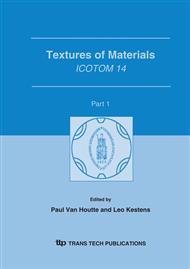p.585
p.591
p.597
p.603
p.609
p.615
p.623
p.633
p.639
Uniformity of Grain Coarsening in Submicron Grained Al-Sc Alloy Containing Local Variations in Texture
Abstract:
The effect of fine particles on the uniformity of grain coarsening in a submicron grained Al-Sc alloy containing significant local variations in texture has been investigated using high resolution EBSD. The alloy was processed by severe plastic deformation and low temperature ageing to generate a fine-grained (0.8 µm diameter) microstructure containing either a dispersion of nanosized Al3Sc particles or a particle-free matrix. The initial processing generated a uniform grain size distribution, but the distribution of grain orientations was inhomogeneous with the microstructure containing colonies of grains consisting predominantly of either HAGBs or LAGBs with the latter possessing orientation gradients of up to 10 o/µm. Despite the marked differences in boundary character between these regions, the alloy undergoes slow and uniform grain coarsening during annealing at temperatures up to 500 oC with no marked change in the grain size distribution, boundary distribution and texture. A model of grain coarsening that takes into account the influence of fine particles on the kinetics of grain growth within an orientation gradient is outlined. The model predicts that a large volume fraction of fine particles (large f/r-value) tends to homogenize the overall rate of grain coarsening despite the presence of orientation gradients in the microstructure.
Info:
Periodical:
Pages:
609-614
Citation:
Online since:
September 2005
Authors:
Price:
Сopyright:
© 2005 Trans Tech Publications Ltd. All Rights Reserved
Share:
Citation:


